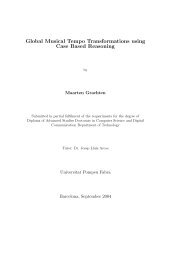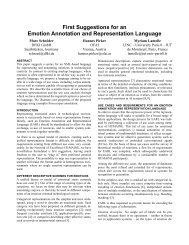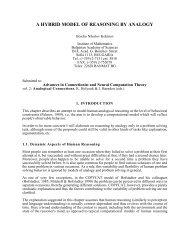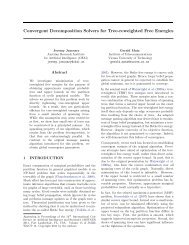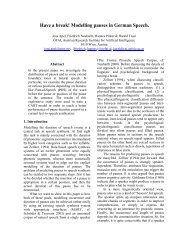Computational Models of Music Similarity and their ... - OFAI
Computational Models of Music Similarity and their ... - OFAI
Computational Models of Music Similarity and their ... - OFAI
Create successful ePaper yourself
Turn your PDF publications into a flip-book with our unique Google optimized e-Paper software.
4 1 Introduction<br />
are described, a demonstration is given, <strong>and</strong> limitations are discussed. The<br />
applications are:<br />
1. Isl<strong>and</strong>s <strong>of</strong> <strong>Music</strong><br />
A metaphor <strong>of</strong> geographic maps is used to visualize the structure<br />
<strong>of</strong> a music collection. Isl<strong>and</strong>s represent groups <strong>of</strong> similar pieces.<br />
Similar pieces are located close to each other on the map. A<br />
technique which allows the user to gradually shift the focus between<br />
different aspects <strong>of</strong> similarity is described. When the focus<br />
is shifted the isl<strong>and</strong>s are gradually rearranged according to the<br />
changing focus on similarity aspects.<br />
2. Fuzzy Hierarchical Organization <strong>Music</strong> collections are hierarchically<br />
organized into overlapping groups. This is done at the artist<br />
level. That is, instead <strong>of</strong> pieces <strong>of</strong> music (as in the other applications)<br />
the smallest entity are artists. Each group <strong>of</strong> similar artists<br />
is summarized with words co-occurring on web pages containing<br />
the artists’ names.<br />
3. Dynamic playlist generation<br />
The user interaction necessary to generate a playlist is minimized.<br />
Using the skip button, the users interactively teach the system<br />
<strong>their</strong> current listening preferences. An evaluation using hypothetical<br />
usage scenarios shows that the suggested heuristic drastically<br />
reduces the number <strong>of</strong> necessary skips.<br />
1.1.1 Contributions <strong>of</strong> this Doctoral Thesis<br />
The contributions can be divided into two categories. The contributions<br />
described in Chapter 2 deal with (mainly audio-based) music similarity measures.<br />
The contributions in Chapter 3 deal with the application <strong>of</strong> similarity<br />
measures. Most <strong>of</strong> the work was carried out in close collaboration with a<br />
number <strong>of</strong> coauthors.<br />
<strong>Similarity</strong> Measures<br />
◦ Development <strong>of</strong> evaluation procedures <strong>and</strong> evaluation <strong>of</strong> similarity<br />
measures [PDW03b; Pam04; PFW05b] including the procedures<br />
<strong>and</strong> evaluation presented in this thesis, which is the largest<br />
evaluation published to date. Important findings include the necessity<br />
<strong>of</strong> using an artist filter, <strong>and</strong> the fact that genre classification<br />
based evaluations can be used instead <strong>of</strong> listening tests to<br />
efficiently evaluate large parameter spaces.




